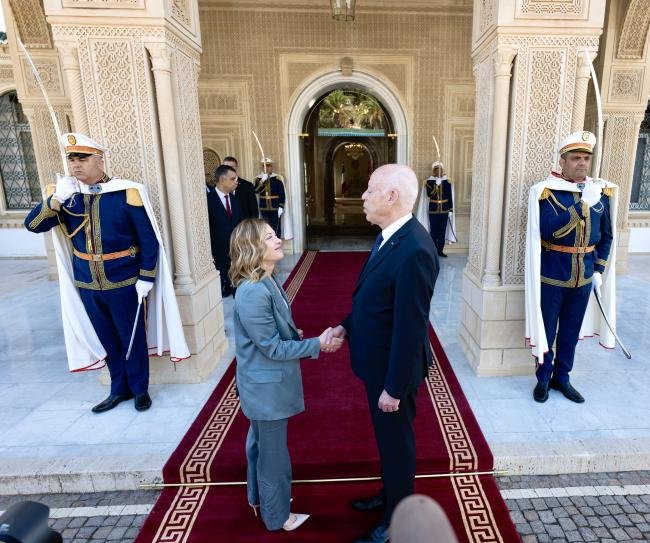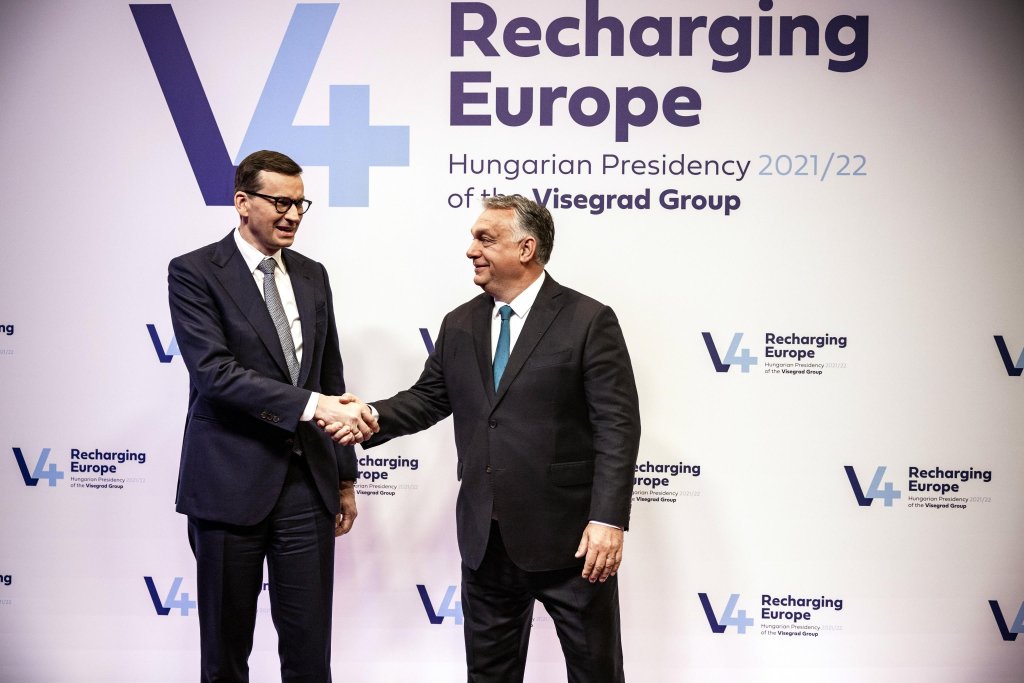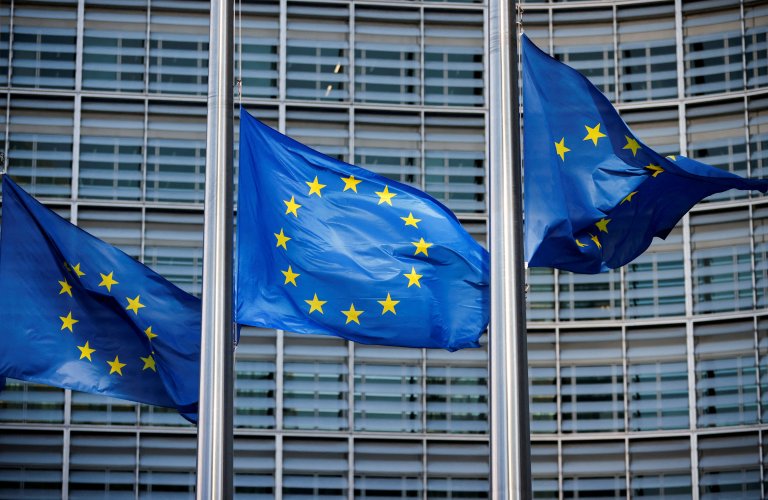The new EU Asylum and Migration Pact, aimed at managing migration across the bloc, was approved by the Parliament at the end of April. InfoMigrants has asked the European Commission to provide more detailed information about the deal.
Between June 6 and 9, countries within the EU will be voting on who will form the next legislature in the European Union.
Just before the end of this term, the EU voted in a package of new laws, the EU Asylum and Migration Pact.
From information provided by the EU online, we laid out the main tenets of the pact, but we still had more questions. A spokesperson at the press office of the EU Commission provided these answers in writing.
Question 1 -- Centers at external EU borders
The pact provides for centers to be built at the external borders of the EU.
When and where will centers be built to process those migrants arriving at the external borders, and who might be eligible for asylum and who would qualify to be sent home?
The EU sent a long answer to this question, but it didn't directly answer the question about the location of the new centers, or when they might be built. What they did say is:
First of all, to clarify: the Pact requires the provision of adequate reception, which includes the use of already existing facilities. [...]
All Member States will be required to have the capacity to host a certain number of asylum seekers for the duration of the procedures in adequate conditions. When the adequate capacity of a given Member State is reached, the Member State concerned is no longer obliged to place additional people in the border procedure; instead, the Member State can channel applicants to the accelerated procedure within the territory.
Should said Member State wish to continue placing people in the border procedure, they would need to ensure that the provisions of the Reception Conditions Directive are respected, for instance by building additional reception capacity or using other existing centers. [...]

Faster and more effective procedures – including screening and border procedures - are an important building block of the Pact. All irregular migrants will be registered upon arrival and will undergo thorough identity, security, health checks and vulnerability screening. Those who are unlikely to need protection, present a security risk or mislead the authorities will be subject to a fast-track border procedure.
This procedure allows for a quick examination of their asylum applications and, if these are rejected, for swift return, all without the person being authorized to enter the territory of the Union. For those of nationalities with a low recognition rate, so under the 20% recognition rate, in principle, unless they are unaccompanied minors or other exclusions apply, they will have to go through border procedure.
That means that Member States will have to ensure that people concerned are treated during the border procedure in locations which are placed either at the external borders or in certain circumstances within the territory.
Question 2 -- Number of centers
How many of those centers will be built?
It is up to the Member States to assign reception facilities, which must be in line with the EU-wide standards outlined in the Pact, as described above.
Question 3 -- Location of centers
Will the centers only be built in EU member states, presumably those on the external borders, or will they also be situated in third countries, such as Tunisia, Egypt, Morocco, and Mauritania, with which the EU has already concluded agreements?
In principle, it is at external borders, but the border procedure can also be carried out in certain circumstances within the Member State territory. Member States will have flexibility when it comes to the locations where the border procedure can be carried out.
Question 4 -- Agreements with non-EU members
How will the arrangements of individual states (for instance Italy's plans in Albania) fit in with these new centers? Will they be part of the same system or will it be up to individual EU states to conclude these kinds of agreements?
Migration is a global reality and an integral part of the broader relationships the EU has with partners worldwide. The Commission has consistently engaged with international partners in a Team Europe approach to address the root causes of migration, fight migrant smuggling, strengthen readmission cooperation and promote legal pathways.
In general, it is possible for the EU and the Member States to cooperate with countries outside the EU in managing migration. It is important that this is done in full respect of EU and international law.
A new paradigm based on comprehensive partnerships is being developed with many of the countries of origin and transit to the EU, including recent initiatives with Tunisia, Mauritania and Egypt. Under this new approach, migration is embedded into the close cooperation with our partner countries alongside other key areas such as economy and trade, investments in green energy, security and people to people relations.
Also read: Italy's Meloni in Libya to talk migration
Question 5 -- Qualifying for asylum
Do you have more details on who might qualify for asylum and who not in the future? Will these rules change in any way to the current rules?
All EU Member States must fully respect obligations under asylum acquis and international law, including ensuring access to the asylum procedure.
Question 6 -- The border procedure
Will all arrivals be subject to this initial processing, or will certain categories, such as families, children, unaccompanied minors, and individuals from countries experiencing conflict, be considered too vulnerable to wait in an initial processing center?
Following the screening, if a person applies for asylum, their application must be examined under the border procedure. The border procedure is a type of accelerated asylum procedure.

The border procedure will apply to a limited number of cases strictly defined in the legislation where the applicant is a national of countries with low recognition rates for international protection; or misleads the authorities; or poses a threat to national security. For others, the regular asylum procedure will apply.
All the necessary safeguards and guarantees will apply during the border procedure.
The concept of 'adequate capacity' [already mentioned in answer 1] requires Member States to set up the reception capacity and human resources, including qualified and well-trained personnel, required to examine at any given moment an identified number of applications and to enforce return decisions.
Although the border procedure should --as a rule-- be carried out at the border or transit zones, Member States will have flexibility to carry out the border procedure in locations within the territory.
Fundamental rights must always be respected. The Charter of Fundamental Rights of the European Union applies when Member States implement EU law. The EUAA and the Commission will pay special attention to conditions in the border procedure. If needed, the Commission can request the EUAA to carry out an ad-hoc monitoring under the new monitoring mechanism of the Agency. If the reception conditions for minors and their family members are not adequate, the border procedure for families with minors will need to be suspended based on a recommendation by the Commission.
Question 7 -- Expected costs
How much is implementing the pact expected to cost?
Almost 9.5 billion euros for the programming period 2021-2027 have already been allocated to Member States through the Home Affairs Funds - AMIF (Asylum, Migration and Integration Fund), BMVI (Border Management and Visa Instrument) and ISF (Internal Security Fund), at the time of their adoption. The AMIF and BMVI funds are particularly relevant to address the financial needs stemming from the Pact.
Importantly, a budget of more than 11 billion euros [2021 -2027] supports the work of the six decentralized agencies: Frontex, eu-LISA (EU Agency for the Operational Management of Large-Scale IT Systems), Europol, EUAA (EU Agency for Asylum), EMCDDA (European Monitoring Center for Drugs and Drug Addiction) and CEPOL (EU Agency for Law Enforcement Training).
In addition, in the programing period 2021-2027, more than 6.7 billion euros have been reserved for the Home Affairs Funds' Thematic Facilities, which ensure flexibility to cater for unforeseen needs. Also here, the AMIF and BMVI Thematic Facilities are particularly relevant for the Pact. For instance, Member States already received significant support under the Thematic Facilities for reception capacity, border controls, resettlement and relocation, integration measures and emergency assistance.
Also read: EU-Lebanon aid package, bad news for refugees?

On top of the already existing allocations mentioned above, Member States will receive additional funds for the Pact implementation:
- 1.9 billion euros from the mid-term review of Member States' programs adopted in 2021 under the three Home Affairs Funds;
- 2 billion euros from the mid-term revision of the EU Multi-annual Financial Framework, out of which 1.8 billion euros will be allocated to Member States, and 0.2 billion euros will be provided to EUAA to support Member States in the Pact implementation.
Both amounts are split over 2025, 2026, and 2027.
Question 8 -- Role of Frontex
Will Frontex play even more of a role in the new initiatives under the terms of the pact, or will its expanding role be in line with the expansion already announced previously?
Concerning the Pact implementation, EU support will include technical, operational and financial support provided by the Commission and EU agencies. The Commission will continue to work on the operational track, supporting Member States, together with the EU Agencies to manage migration with targeted actions.
The Pact on Migration and Asylum builds on the EBCG Regulation and foresees the Agency contributing to several dimensions of the Regulation, especially given its enhanced role in returns (see also the Frontex Evaluation Report).
Frontex fulfils a critically important task, as its mission is to help Member States protect the common European Union external borders, and to uphold fundamental rights in doing so. To achieve this, Frontex must be a robust and well-functioning agency, with the right governance and control systems in place. At operational level, Frontex will provide support in all phases of the return process (pre-return, return operations and post-return including reintegration support).
Question 9 -- Readmission agreements
Do you seek to conclude more readmission agreements? If so, with which countries?
Developing legal migration must also go hand in hand with strengthened cooperation on readmission. As part of a functioning asylum and migration system, those who have no legal right to stay in Europe must be returned. The EU Return Coordinator is working closely on this with Member States in the High-Level Network for Returns.
A new paradigm based on comprehensive partnerships is being developed with many of the countries of origin and transit to the EU, including recent initiatives with Tunisia, Mauritania and Egypt.
The EU and its Member States are the world's leading donor to support refugees, and the largest provider of development assistance. The comprehensive partnerships are complemented by the "whole-of-the-route approach" covering all aspects, from dealing with the root causes of irregular migration to cooperation on other aspects of migration and border management and border (Action Plans on Central Mediterranean, Western Balkans, Western Mediterranean and the Atlantic, Eastern Mediterranean routes).

Question 10 -- Solidarity mechanism
In terms of the solidarity pledge, how do you hope to make that work more effectively than it has done so far?
Will there be more support for frontline states to support the increased number of asylum seekers or do you expect to see a reduction in the overall number because of more efficient sorting mechanisms?
For the first time, the Union will have in place a permanent mandatory solidarity mechanism. No Member State will be left alone under pressure. At the same time, each Member State will contribute to the solidarity efforts in a flexible way, and they will be able to choose the type of solidarity they provide. The system will also include effective rules to detect and prevent secondary movements.
In order to decide who benefits from solidarity, the Commission assesses which Member States are under migratory pressure or facing a significant migratory situation.
Migratory pressure is mainly defined by a large number of arrivals (or risk thereof) or applications that will create disproportionate obligations (i.e., because that Member State will have the responsibility to examine a large number of applications) in a well-prepared system.
Significant migratory situations takes into consideration the cumulative effect of current and previous annual arrivals of non-EU nationals and stateless people. In a significant migratory situation, the determining factor is not the number of arrivals (they do not have to be of a large scale) but their cumulative impact, so that over time, because of this cumulation a Member State that is well prepared might be reaching the limits of its capacity. This could happen for example to Member States that are facing secondary movements over time.
Also read: Reform of the Schengen agreement, free movement or authorized pushbacks?
Question 11 -- Responsibility offsets
In the outline of the new pact, the EU mentioned that part of the solidarity mechanism would include 'responsibility offsets'. We asked, what exactly are 'responsibility offsets'?
If a Member State is under pressure, an important measure to alleviate this pressure is reducing the number of asylum applications that the Member State concerned is required to examine (i.e. the Member State under pressure is alleviated of the responsibility for a given number of asylum applicants). The AMMR foresees two possibilities for reducing the responsibility of the Member State under pressure for a given number of asylum applicants:
Relocation of applicants for international protection to other Member States. In this case, an applicant who is the responsibility of the Member State under pressure is transferred to another Member State who will then become responsible to examine the asylum application.
Reducing the number of applicants that should be sent back to the Member State under pressure using 'responsibility offsets.' This measure covers those whose asylum applications should have been examined by the Member State under pressure but who moved to another Member State in an unauthorized way. Under the responsibility rules, these applicants should be sent back to the Member State under pressure. However, the Member State where the applicant is physically present takes the responsibility to examine the asylum application instead of transferring the applicant back to the Member State under pressure. For example: Country A has been asked to relocate 20 people from Country B but can choose instead to take over responsibility for 20 people already present in Country A but for whom Country B is normally responsible and whom country A could normally return to Country B. This will be counted as a form of solidarity.

As the objective of both measures is to reduce the number of applicants whose asylum applications should be the responsibility of the Member State under pressure, these two measures - relocation and responsibility offsets- are called 'people solidarity'.
While there is no mandatory relocation, 'responsibility offsets' may become mandatory in certain cases, including if relocation pledges are insufficient to cover a minimum of relocation needs (30,000 or 60% of the relocation needs identified by the Council in its decision setting up the annual solidarity pool, whichever number is higher). In this way, Member States under pressure will have the guarantee of receiving 'people solidarity,' i.e. being alleviated of the responsibility for a given number of asylum applicants. However, as responsibility offsets can only apply to applicants that are already on the territory of the Member State that is applying the offset, if a Member State does not have applicants on its territory to offset, that Member State cannot be required to carry out offsets. Furthermore, no Member State is obliged to offset applicants beyond their fair share. Both relocation and responsibility offsets will be overseen by a Solidarity Coordinator in the Commission.
Question 12 -- Solidarity mechanism and compliance
The solidarity mechanism has not been taken up by all EU states in the past, and has been contested by some, in particular states in Eastern Europe along the so-called Balkan route.
Will there be sanctions applied to states that do not want to participate in the solidarity mechanism?
The reform includes a series of safeguards as well as checks and balances that create incentives for compliance and should facilitate the implementation of the solidarity mechanism.
For instance:
- Only Member States with well-prepared systems can be eligible for solidarity or for deductions in their solidarity obligations. A well-prepared system is a main requirement under the definition of 'migratory pressure' (which is a pre-condition to receive solidarity) and 'significant migratory situation' (which allows a Member State to benefit from deductions in their solidarity contributions).
- If a Member State does not pledge or does not comply with its solidarity obligations, the benefitting Member State can force mandatory offsets and the Commission can recover the financial contributions (as appropriate).
- If a Member State is not complying with its responsibility obligations, the other Member States are not obliged to comply with the solidarity obligations in relation to that Member State.
- If there is not a sufficient amount of relocation pledges to meet the minimum of 'people solidarity' that has to be ensured by the Union, responsibility offsets become mandatory, acting as a backstop to ensure the minimum of people solidarity at EU level (meaning, that the Member States under pressure will be alleviated by not taking responsibility for a fixed number of people annually).
- The High-Level Solidarity Forum, composed of Member State Ministers, can be convened at any time where there is a problem, including a need to conduct a new pledging exercise, while the day-to-day operationalization of solidarity will be ensured through the Technical-Level Solidarity Forum.
Ultimately, if Member States do not comply with the rules within two years, the Commission can make use of its powers under the Treaty (infringements).
Question 13 -- Principle of first entry
Under the pact fact sheet, you mention that migrants are obliged to apply for asylum in the country of first entry. However, that is officially the current situation. Why has this been underlined as a change? And won't this continue the 'burden' of pressure on the 'frontline' states such as Italy or Greece?
The principle of first entry still remains, however the new rules enhance the responsibility criteria and the rules for determining the Member State responsible for assessing an asylum application.
There will be clearer rules on responsibility for assessing the asylum applications, such as:
- applying for international protection in the Member State of first entry (unless the person is not in possession of a valid visa or residence permit or authorized to travel visa-free in the Union), where the applicant is obliged to be during the determination of the Member State responsible;
- full cooperation with the authorities for identification of the Member State responsible, including obligation to cooperate for the collection of biometric data and to present documents relevant for determining his/her identity;
- compliance with the transfer decision and to cooperate fully for its implementation.

Non-compliance with these obligations has clear legal consequences for the applicant, such as:
- the full set of the material reception conditions are provided only in the Member State where the applicant is supposed to be under the AMMR rules, if the applicant is in another Member State – only the basic needs are covered;
- Member State authorities determining the responsibility are obliged to continue (the determination) even if the applicant is not present on their territory, i.e. the applicant that violates the requirement to be present in that Member State will not be entitled to a personal interview and to give/clarify the information on his/her case;
- non-compliance with the transfer decision, as well as absconding, after the issuance of a transfer decision gives rise to an extended timeline for implementing the transfer (from 18 months under the old rules to three years under the new rules).
Question 14 -- Secondary movements
When you say the take-back state has to take someone back even when the application hasn't been lodged in time, does that mean that the six-month limit will be lifted / will no longer apply? So even someone detected say in Germany three years after they entered the EU could be sent back to Italy or Greece and Italy or Greece would have to comply?
When it comes to preventing secondary movements, the obligations for applicants have been made clearer and stricter. When an applicant moves in an unauthorized way from one Member State to another, the AMMR foresees the possibility to transfer the person from the Member State where the person is physically present to the Member State where the person is required to be legally present. This transfer is called a 'take-back procedure'.
From a lengthy and complicated procedure based on requests between Member States and exchange of proofs and evidence, the take-back procedure will become a simple notification procedure. This means that the Member State where the person is present without any (legal) reason can simply notify the Member State responsible and proceed swiftly with the transfer decision.
There will be no shift of responsibility if the take-back notification is not sent on time (by the Member State on whose territory the person is present). This means that they can notify the person's presence and consequently organize their transfer at any time.
Also read: EU's Mediterranean states discuss EU Migration Pact
Question 15 -- Legal obligations
What could be the potential effects of migrants or asylum seekers only receiving 'basic' welfare support if they are found to have moved to a second country from their original entry point? Could you elaborate on this mechanism?
The reform creates new safeguards for asylum seekers and vulnerable people, particularly minors and families with children. It introduces free legal counselling for all applicants in all asylum procedures, including the responsibility determination procedure, and it strengthens information rights.

In particular there are: new and strengthened information rights for applicants across all new legislative acts, so that applicants will understand their rights, obligations and the consequences of non-compliance with their obligations. Today we are confronted with many cases in which persons abuse the system; for example, making last minute applications to delay the enforcement of a return decision, or applying multiple times (subsequent applications) without bringing new elements to substantiate the claim.
These abusive claims and subsequent applications will be as a rule subject to accelerated procedures, be it at the border or within the territory depending on the particular case. In addition, if the person absconds and applies in another Member State, that Member State must only cover the applicant's basic needs and must treat the application as a subsequent application (if there is no possibility for sending the person back to the first Member State).
Question 16 -- Expected changes
What other changes might migrants experience in the future on arrival in an EU-member state?
The Pact creates a common European system that sets up a new process for managing migration, while also catering for crisis situations and instrumentalization.
For more information on the new legislations, and the different categories, see our Q&A.
